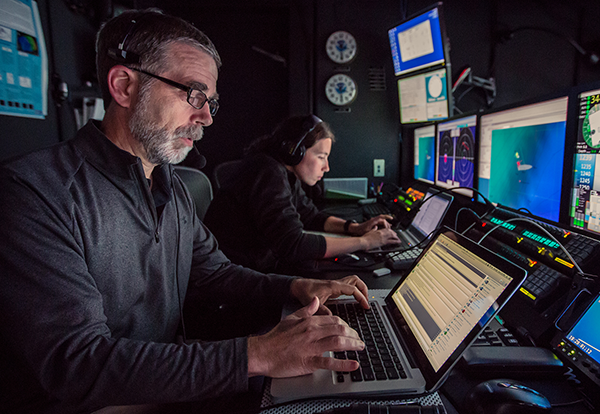A University of Louisiana at Lafayette oceanographer is leading researchers to unexplored deep-sea habitats of the North Atlantic Ocean. And the public can tag along, thanks to technology.
Dr. Scott France, a professor in UL Lafayette’s Department of Biology, is guiding an expedition from Virginia to Portugal aboard NOAA Ship Okeanos Explorer, a 225-foot, federally funded research vessel. The expedition began July 9 and will end July 30.
Scientists are plumbing the depths at about a dozen planned stops, examining underwater topography and marine ecosystems. Those efforts are happening via sonar mapping technology and a small submersible vehicle that is tethered to the Okeanos via fiber-optic cable.
Once deployed, the remotely operated vehicle, or ROV, functions as a multitasking underwater robot. It captures high-definition video and images of the water column, seafloor habitats, and aquatic life; the ROV also collects biological and geological samples.
“Technology has basically enabled us to get our eyes on the seafloor, and we don’t know exactly what’s down there. We’re going places no one has ever seen before, and that’s part of the interest, finding out what’s there and why it’s there,” France said.
Among scientists’ primary objectives are to map and learn about seafloor topography, including tectonic plate boundaries, volcanic features and activity, and hydrothermal vents, which are fractures that discharge geothermally heated water.
The marine life that thrives near those vents is of particular interest to France. “You have various chemicals in that water that you wouldn’t normally find. Bacteria can use those chemicals, and you get huge populations that support other kinds of deep sea life,” he explained.
Deep regions of the world’s oceans, France added, don’t typically support abundant marine life “because there isn’t much food – which comes from where there’s sunlight – except at hydrothermal vents.”
“That’s why they’re so special and unique, because they have this source of energy. So you get to see some spectacular things around them,” he said.
During each dive, the ROV beams video images back to researchers aboard the ship in real time; several seconds later, scientists from across the world who have registered to participate virtually see those same images.
UL Lafayette graduate and undergraduate biology students being mentored by France are following the expedition virtually from campus as part of lab research, for classroom projects, or to complete dissertations related to expedition discoveries.
So, too, is the public, which is able to access a separate feed online. “Anyone who tunes in gets to see this stuff for the first time, at almost the same time scientists are seeing it,” France said.
The expedition France is leading constitutes one leg of the larger Voyage to the Ridge 2022, which is funded by the National Oceanic and Atmospheric Administration. The overall voyage, which will unfold in three parts, began May 11. It will end Aug. 18, when the Okeanos docks in the U.S. Virgin Islands.
For his time aboard the ship, France boarded the vessel at Norfolk, Va., and will disembark in Azores, Portugal. His stake in the expedition won’t end there.
France is also the scientific advisor for a broader NOAA campaign. Scientists have been exploring never before seen regions of the North Atlantic since 2017. The current trip is the fourth journey for which France has been a science lead.
During past expeditions, discoveries have included new species of jellyfish, sea stars, corals and sponges. “We constantly find new species, but we also witness lots of interesting behaviors. That’s one of the great things about the video – we get the behavioral biology, not just a static collection of something,” France said.
Beyond scientific value, much of what is encountered “is just plain cool, especially because a lot of it is unexpected and happens very quickly,” he explained.
On past expeditions, France has observed a brittle star, a starfish-like creature with thin, undulating arms, snatch a squid from the water column, for example. He’s seen a shark in a feeding frenzy get eaten by an enormous grouper, which are fish with large, gaping mouths.
The ROV has also relayed video and images of cultural bounty back to the Okeanos – shipwrecks. Still, France often remains most astonished at “how much color and diversity there is down there and how many things are moving around.”
“It’s always a bit of a surprise, and a lot of times it’s really quite beautiful and exciting because many of the organisms are just so unusual and so rare.”
Learn more about Voyage to the Ridge 2022 or how to follow the expedition online.
Photo caption: UL Lafayette’s Dr. Scott France aboard the NOAA Ship Okeanos Explorer during a past expedition. He has returned to the ship as part of a three-week research voyage to explore uncharted depths of the North Atlantic Ocean. Submitted photo
